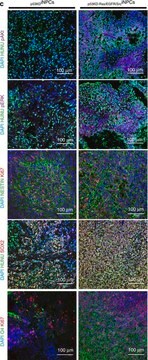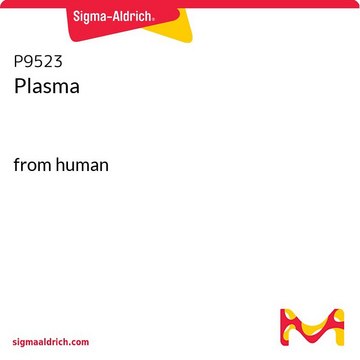MAB5606Z
Anticorps anti-ganglioside GD1a, clone GD1a-1 (sans azoture)
clone GD1a-1, from mouse
Synonyme(s) :
GD1a Ganglioside
About This Item
Produits recommandés
Source biologique
mouse
Niveau de qualité
Forme d'anticorps
purified immunoglobulin
Type de produit anticorps
primary antibodies
Clone
GD1a-1, monoclonal
Espèces réactives
bovine, human, fish, mouse, rat
Réactivité de l'espèce (prédite par homologie)
vertebrates (based on 100% sequence homology)
Technique(s)
ELISA: suitable
immunohistochemistry: suitable (paraffin)
Isotype
IgG1κ
Conditions d'expédition
dry ice
Modification post-traductionnelle de la cible
unmodified
Description générale
Spécificité
Immunogène
Application
Analyse par ELISA : la spécificité de la cible d'un lot représentatif a été déterminée par analyse ELISA (Gong, Y., et al. (2002). Brain. 125(Pt 11):2491-2506).
Analyse par immunohistochimie : un lot représentatif a permis de détecter l'immunoréactivité du GD1a dans des coupes de cerveau médio-sagittales congelées fraîches provenant de souris de type sauvage et de souris St3gal2/3-double-nulles (Sturgill, E.R., et al. (2012). Glycobiology.22(10):1289-1301).
Analyse par immunohistochimie : un lot représentatif a permis de détecter l'immunoréactivité du GD1a dans diverses régions du cerveau de poisson en utilisant des coupes flottantes (Viljetić, B., et al. (2012). Biochim. Biophys. Acta. 1820(9):1437-1443).
Analyse par immunohistochimie : un lot représentatif a permis de détecter le GD1a dans des coupes de cerveau humain et de rat fraîches congelées par immunohistochimie fluorescente et non fluorescente (Gong, Y., et al. (2002). Brain. 125(Pt 11):2491-2506).
Analyse immunologique par superposition : un lot représentatif a permis de détecter le GD1a dans le cerveau bovin, ainsi que le GD1a dans des extraits de gangliosides de racine ventrale et dorsale humaine (Gong, Y., et al. (2002). Brain. 125(Pt 11):2491-2506).
Neurosciences
Neurosciences du développement
Qualité
Analyse par immunohistochimie : une dilution au 1/50e de cet anticorps a permis de détecter la protéine ganglioside GD1a dans du tissu cardiaque humain.
Liaison
Forme physique
Stockage et stabilité
Recommandations relatives à la manipulation du produit : dès réception, et avant le retrait du bouchon, centrifuger le flacon et mélanger délicatement la solution. Répartir en aliquotes dans des microtubes à centrifuger et conserver ces derniers à -20 °C. Éviter les congélations/décongélations répétées, qui peuvent détériorer les IgG et nuire aux performances du produit.
Autres remarques
Clause de non-responsabilité
Vous ne trouvez pas le bon produit ?
Essayez notre Outil de sélection de produits.
Code de la classe de stockage
12 - Non Combustible Liquids
Classe de danger pour l'eau (WGK)
WGK 1
Point d'éclair (°F)
Not applicable
Point d'éclair (°C)
Not applicable
Certificats d'analyse (COA)
Recherchez un Certificats d'analyse (COA) en saisissant le numéro de lot du produit. Les numéros de lot figurent sur l'étiquette du produit après les mots "Lot" ou "Batch".
Déjà en possession de ce produit ?
Retrouvez la documentation relative aux produits que vous avez récemment achetés dans la Bibliothèque de documents.
Notre équipe de scientifiques dispose d'une expérience dans tous les secteurs de la recherche, notamment en sciences de la vie, science des matériaux, synthèse chimique, chromatographie, analyse et dans de nombreux autres domaines..
Contacter notre Service technique







